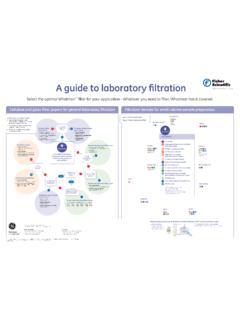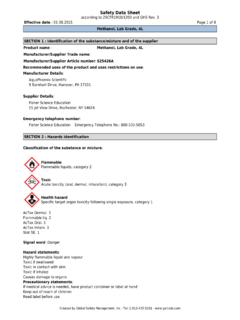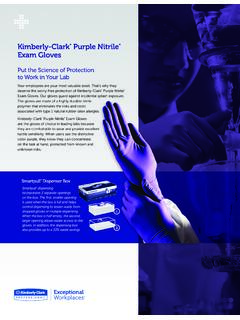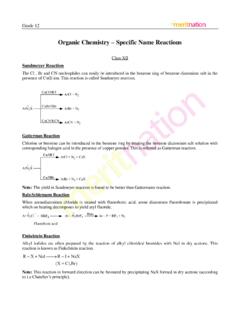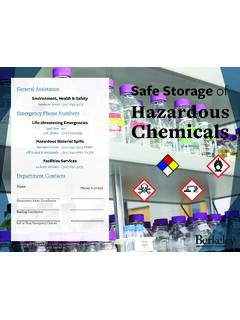Transcription of Safety Data Sheet - Fisher Sci
1 Safety data Sheetaccording to 29 CFR1910/1200 and GHS Rev. 3 Effective date : 1 of 7 sodium Carbonate,AnhydrousCreated by Global Safety Management, Inc. -Tel: 1-813-435-5161 - 1 : Identification of the substance/mixture and of the supplierProduct name : sodium Carbonate,AnhydrousManufacturer/Supplier Trade name:Manufacturer/Supplier Article number:S25539 DRecommended uses of the product and uses restrictions on use:Manufacturer Details:AquaPhoenix Scientific9 Barnhart Drive, Hanover, PA 17331 Supplier Details: Fisher Science Education15 Jet View Drive, Rochester, NY 14624 Emergency telephone number: Fisher Science Education Emergency Telephone No.: 800-535-5053 SECTION 2 : Hazards identificationClassification of the substance or mixture:IrritantEye irritation, category 2 AEye Irritation 2 Signal word :WarningHazard statements:Causes serious eye irritationPrecautionary statements:If medical advice is needed, have product container or label at handKeep out of reach of childrenRead label before useDo not eat, drink or smoke when using this productWear protective gloves/protective clothing/eye protection/face protectionWash skin thoroughly after handlingIF IN EYES: Rinse cautiously with water for several minutes.
2 Remove contact lenses if present and easy to rinsingIf eye irritation persists get medical advice/attentionOther Non-GHS Classification:WHMISD2 BESafety data Sheetaccording to 29 CFR1910/1200 and GHS Rev. 3 Effective date : 2 of 7 sodium Carbonate,AnhydrousCreated by Global Safety Management, Inc. -Tel: 1-813-435-5161 - SCALE (0-4)HMIS RATINGS (0-4)SECTION 3 : Composition/information on ingredientsIngredients:CAS 497-19-8 sodium Carbonate, Anhydrous100 %Percentages are by weightSECTION 4 : First aid measuresDescription of first aid measuresAfter inhalation: Move exposed individual to fresh air. Loosen clothing as necessary and position individual ina comfortable medical advice if discomfort or irritation breathing difficult, give skin contact: Wash affected area with soap and water. Rinse thoroughly. Seek medical attention ifirritation, discomfort or vomiting eye contact: Protect unexposed eye.
3 Rinse/flush exposed eye(s) gently using water for 15-20 contact lens(es) if able to do so during rinsing. Seek medical attention if irritation persists or swallowing: Rinse mouth thoroughly. Do not induce vomiting. Have exposed individual drink sips ofwater. Seek medical attention if irritation, discomfort or vomiting important symptoms and effects, both acute and delayed:Irritation, Nausea,Headache, Shortness of (substance which increases flow of tears).;Indication of any immediate medical attention and special treatment needed:If seeking medical attention, provide SDS document to 5 : Firefighting measuresExtinguishing mediaSuitable extinguishing agents: If in laboratory setting, follow laboratory fire suppression procedures. Useappropriate fire suppression agents for adjacent combustible materials or sources of ignitionFor Safety reasons unsuitable extinguishing agents:Special hazards arising from the substance or mixture:Combustion products may include carbon oxides or other toxic decomposition can lead torelease of irritating gases and for firefighters:Protective equipment: Use NIOSH-approved respiratory protection/breathing information (precautions): Move product containers away from fire or keep cool with waterSafety data Sheetaccording to 29 CFR1910/1200 and GHS Rev.
4 3 Effective date : 3 of 7 sodium Carbonate,AnhydrousCreated by Global Safety Management, Inc. -Tel: 1-813-435-5161 - as a protective measure, where 6 : Accidental release measuresPersonal precautions, protective equipment and emergency procedures:Wear protective equipment. Avoid dispersal of dust in the air ( , clearing dust surfaces with compressed air).Follow good hygiene procedures when handling chemical materials. Use respiratory protective device againstthe effects of fumes/dust/aerosol. Keep unprotected persons away. Ensure adequate awayfrom ignition sources. Protect from the spill, if possible. Contain spilled material by diking or usinginert absorbent. Transfer to a disposal or recovery precautions:Prevent from reaching drains, sewer or waterway. Collect contaminated soil for characterization per Section 13 Methods and material for containment and cleaning up:If in a laboratory setting, follow Chemical Hygiene Plan into properly labeled containers forrecovery or disposal.
5 If necessary, use trained response and containerize for generating dust. Collect solids in powder form using vacuum with (HEPA filter)Reference to other sections:SECTION 7 : Handling and storagePrecautions for safe handling:Follow good hygiene procedures when handling chemical materials. Do not eat, drink, smoke, or use personalproducts when handling chemical substances. If in a laboratory setting, follow Chemical Hygiene onlyin well ventilated generation of dust or fine contact with eyes, skin, and hands after handling. Avoid dispersal of dust in the air ( , clearing dust surfaces with compressed air).Conditions for safe storage, including any incompatibilities:Store in a cool location. Provide ventilation for containers. Avoid storage near extreme heat, ignition sources oropen flame. Store away from foodstuffs.
6 Store away from oxidizing in cool, dry conditions in wellsealed containers. Keep container tightly 8 : Exposure controls/personal protectionControl Parameters:No applicable occupational exposure limitsAppropriate Engineering controls:Emergency eye wash fountains and Safety showers should be available inthe immediate vicinity of exhaust ventilation orother engineering controls to keep the airborne concentrations of vaporor dusts (total/respirable) below the applicable workplace exposure limits(Occupational Exposure Limits-OELs) indicated under a fumehoodRespiratory protection:Not required under normal conditions of use. Use suitable respiratoryprotective device when high concentrations are present. Use suitablerespiratory protective device when aerosol or mist is formed. For spills,respiratory protection may be data Sheetaccording to 29 CFR1910/1200 and GHS Rev.
7 3 Effective date : 4 of 7 sodium Carbonate,AnhydrousCreated by Global Safety Management, Inc. -Tel: 1-813-435-5161 - of skin:The glove material has to be impermeable and resistant to the product/the substance/ the preparation being of the glovematerial on consideration of the penetration times, rates of diffusion andthe protection: Safety glasses with side shields or hygienic measures:The usual precautionary measures are to be adhered to when handlingchemicals. Keep away from food, beverages and feed remove all soiled and contaminated clothing. Wash handsbefore breaks and at the end of work. Do not inhalegases/fumes/dust/mist/vapor/aeroso ls. Avoid contact with the eyes 9 : Physical and chemical propertiesAppearance (physicalstate,color):White solidExplosion limit lower:Explosion limit upper:Not determinedNot determinedOdor:OdorlessVapor pressure:1 mmHg @ 865 COdor threshold:Not determinedVapor density:Not determinedpH-value:Not determinedRelative density:Not determinedMelting/Freezing point:851 CSolubilities:Partly soluble in water.
8 220 g/l at20 CBoiling point/Boilingrange:1600 C @760mmHgPartition coefficient (n-octanol/water):Not determinedFlash point (closedcup):Not determinedAuto/Self-ignitiontemperature: Not determinedEvaporation rate:Not determinedDecompositiontemperature:Not determinedFlammability(solid,gaseous):No t determinedViscosity:a. Kinematic:Not determinedb. Dynamic: Not determinedDensity: Not determinedSpecific 10 : Stability and reactivityReactivity:Chemical stability:No decomposition if used and stored according to hazardous reactions:Conditions to avoid:Store away from oxidizing agents, strong acids or materials:Strong oxidizers, strong acids, fluorineHazardous decomposition products:Carbon oxides (CO, CO2).Oxides of sodiumSECTION 11 : Toxicological informationAcute Toxicity:Oral:4090mg/kgLD50 oral-rat: Safety data Sheetaccording to 29 CFR1910/1200 and GHS Rev.
9 3 Effective date : 5 of 7 sodium Carbonate,AnhydrousCreated by Global Safety Management, Inc. -Tel: 1-813-435-5161 - :2300 mg/m3LC50 (2h) RatDermal:2210 mg/kgLD50 MouseChronic Toxicity: No additional Irritation:Ocular:Section 2 Classified as an eye irritantSensitization:No additional Target Organ (STOT):No additional Measures:No additional :No additional :No additional Toxicity:No additional 12 : Ecological informationEcotoxicityFish: LC50 (96h) L. macrochius: 300 mg/lFish: LC50 (96h) P. promelas (various age groups): 310-1220 mg/lCrustacea - LC50; Species: D. magna : 265 mg/LPersistence and degradability: Readily degradable in the potential: No bioaccumulationMobility in soil:Other adverse effects:SECTION 13 : Disposal considerationsWaste disposal recommendations:Product/containers must not be disposed together with household garbage.
10 Do not allow product to reachsewage system or open is the responsibility of the waste generator to properly characterize all wastematerials according to applicable regulatory entities (US ). Consult federal state/ provincial andlocal regulations regarding the proper disposal of waste material that may incorporate some amount of 14 : Transport informationUN-NumberNot proper shipping nameNot hazard class(es)Packing group:Not RegulatedEnvironmental hazard:Transport in bulk:Special precautions for user: Safety data Sheetaccording to 29 CFR1910/1200 and GHS Rev. 3 Effective date : 6 of 7 sodium Carbonate,AnhydrousCreated by Global Safety Management, Inc. -Tel: 1-813-435-5161 - 15 : Regulatory informationUnited States (USA)SARA Section 311/312 (Specific toxic chemical listings):None of the ingredients is listedSARA Section 313 (Specific toxic chemical listings):None of the ingredients is listedRCRA (hazardous waste code):None of the ingredients is listedTSCA (Toxic Substances Control Act):All ingredients are (Comprehensive Environmental Response, Compensation, and Liability Act):None of the ingredients is listedProposition 65 (California):Chemicals known to cause cancer:None of the ingredients is listedChemicals known to cause reproductive toxicity for females:None of the ingredients is listedChemicals known to cause reproductive toxicity for males:None of the ingredients is listedChemicals known to cause developmental toxicity.





